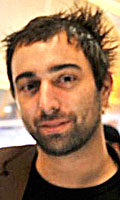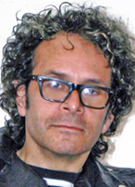Noted designer guides student's in shape, materials exploration

Roland Snooks

Gabriel Esquivel
Working under the tutelage of an algorithmic design expert and an aerospace engineer, students in an experimental design studio at Texas A&M recently created prototypes for two unconventional home exteriors fabricated from innovative composite building materials.
The futuristic, organically shaped forms for a cliffside dwelling and a prairie home were imagined by environmental design students in the Spring 2012 Mitchell Visiting Designer Lab, an extremely rigorous residential design studio funded in part by the Mitchell Initiative, a $2.3 million endowment from the Bryan N. Mitchell family, owners of History Maker Homes in Fort Worth.
“The project takes an experimental approach, exploring new forms of space, new materials and new textures in a complete break from traditional home design,” said Jorge Vanegas, dean of the College of Architecture. “Through technology and the process of discovery, students are seeing the possibilities of new shapes and forms, new materials and textures that have the potential to dramatically shift the traditional view of what a home is into a completely different realm.”
Guiding 35 second-and fourth-year environmental design students through the conceptual experiment was visiting architect Roland Snooks, design director and founding partner of [Kokkugia] (http://www.kokkugia.com/) , a progressive architecture and urban design practice with offices in New York, London and Melbourne. His work, which has been extensively published and internationally exhibited, explores generative design methodologies developed from the complex, self-organizing behavior of biological, social and material systems.
As the lab’s spring 2012 visiting designer, Snooks made three visits to campus to work with the Mitchell Lab students and met with them twice weekly via videoconference calls.
“Contact with internationally acclaimed designers and firms like Kokkugia introduces students to new design techniques and approaches while exposing them to the world of architecture they will soon be entering,” said Mitchell Lab instructor Gabriel Esquivel, assistant professor of architecture at Texas A&M. “In turn, those engaging our students gain new ideas from the next generation of architects.”
Snooks’ influence is evident in the complex geometry of the students’ prototypes, representative sections of the experimental structures' exterior, which were shaped and assembled at the College of Architecture’s Riverside Campus [Digital Fabrication Facility] (http://www.arch.tamu.edu/inside/services/digital-fabrication/) .
The distinctive structures incorporate a weatherproof skin fashioned from epoxy resin and c-glass, a fiber-reinforced material.
To evaluate the structural integrity of these composite materials, students received assistance from Darren Hartl, assistant professor of aerospace engineering at [Texas A&M’s Shape Memory Alloy Research Team] (http://smart.tamu.edu/overview/overview.html) .
“The collaboration with Hartl helped students understand how quantitative information from structural response analysis can inspire aesthetic elements in the design process,” said Esquivel.
The exercise provided an opportunity for students to explore and visualize cutting-edge architectural solutions made possible by the fusion of computational technology, advanced mathematic algorithms and modern building materials, said Vanegas.
“Little by little, we are moving toward solutions that once seemed impossible, but because the results of these kinds of explorations clash with what the conventional notion of what a home is, the work is not without controversy,” he said. “What Roland Snooks does with digital fabrication and emerging materials is exciting, because it is starting to make a dent in the traditional conception of what a home is.”
With computational prototyping projects like those undertaken in the Mitchell Lab, Texas A&M is “generating a strong culture of architectural experimentation” said Mark Gage, assistant dean of the [Yale School of Architecture] (http://www.architecture.yale.edu/drupal/) and founding partner of New York’s [Gage/Clemenceau Architects] (http://gageclemenceau.com/home/) , after participating in an April 23 review of the Mitchell Lab projects. “There are very few schools doing this,” he said.
“It’s important for you guys to know you are at an institution that is supporting some of the most important material and computational research in the world, Gage told the students. “I support in the strongest possible terms what you guys are doing.”
The design studio's structure, a vertical mix of of second- and fourth-year design students, enhance its effectiveness, said Esquivel, by creating unique opportunities for discourse and new ideas.
“Often second-year students bring ideas to the table that do not occur to, or are too easily dismissed by fourth-year students, who in turn, can impart knowledge that underclassmen have yet to learn,” said Esquivel. "This dialogue improves the overall quality of student work while getting students used to working in large architectural project groups."
The rigorous research and design innovation demanded by a studio undertaking such ambitious projects are inevitably reflected in the final product, said Esquivel. “Through collaboration, research and hard work, students produce at or near a professional level.”
This work was enabled by funds provided for the History Maker Homes Residential Studio, established by the Mitchells to revolutionize teaching in residential construction and design at Texas A&M, and by two other Mitchell Family endowments: the Sandy and Bryan Mitchell Master Builder Chair and the Liz and Nelson Mitchell Professorship.
Previous post
Tags
- applied creativity
- architecture
- building a better texas
- college culture
- fabrication
- feature
- interdisciplinary
- partnerships
- research
- rss
- studio projects
- technology
- undergraduate work
Related Posts

Texas A&M researchers enabling buildings to ‘breathe’
NSF group melding art, science learning

Innovative ‘green’ wall features sheet metal, native plants

TAMU team uses robot to design complex structure

Initiative fusing arts, technology education gains momentum
Follow Us
Facebook Twitter Vimeo Youtube Flickr RSS
Recent Posts

Planning prof heads study of disaster housing aid

A message from the dean

Former student remembered as expert planner

Leading educator named new head of Architecture Dept.












_thumbnail_small.png)
